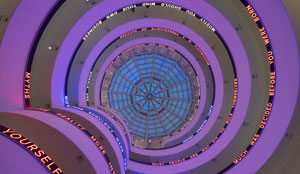9.27.24 — Breaking the Silences
Jenny Holzer has a way with words. She also has a way with silence.
For a time her crawl screens were seemingly everywhere—speaking for you, standing up to you, and getting under your skin. Text art will never speak so forcefully and so elusively again. It made her not just the voice, but the voices of political and postmodern art. Were they never spoken aloud?  It brought her to street posters in the 1970s, for Truisms and Inflammatory Essays, and to the ramp of the Guggenheim in 1989. This is not sound art, although that has its place, but it echoes once again through the museum.
It brought her to street posters in the 1970s, for Truisms and Inflammatory Essays, and to the ramp of the Guggenheim in 1989. This is not sound art, although that has its place, but it echoes once again through the museum.
Now she recreates that work, but with additional words, because for her the same old words will never suffice. They ascend on LED along the rim of the ramp, facing outward onto the rotunda, with selected work from over fifty years in the bays by the wall, as “Light Line,” through September 29. It is a retrospective as a work in progress, her first in New York since 2009, and text keeps coming, apart from conspicuous gaps and silences. The empty bays and floors all but empty of art speak loudly, too. They allow her words to echo in the silence, and they bring out how much she refuses to say. As it happens, Joyce Kozloff in paint keeps up with the news, too, with maps, and I work this together with a report earlier this year on Kozloff as a longer review and my latest upload.
You may remember Jenny Holzer for the crawl screens, and you could almost take in her show at the Guggenheim without ever leaving the rotunda. It does not have much in the way of seating, but then her art does not run to creature comforts. You might have to stand and crane your head, but it is hard not to keep looking as the words ascend. They emerge from the lobby wall, come into view, and come into view again as they complete the circle and move on to the next. Their terse messages are instantly memorable—and ever so easy to forget as new messages finish them, contradict them, and supplant them. It says something that a review in The New York Times misquoted one of her best known.
Abuse of Power Comes as No Surprise, it goes, and you may have read it yourself on billboards, screen prints, and of course crawl screens. It has such an impact because it, too, may or may not come as a surprise. You are used, you may think, to politics as the abuse of power, and it may have driven you further to the left or to a protest vote for Donald J. Trump. The message can still come as a shock, though, if you expect “abuse of power” to end with something less banal, like a condemnation or an expression of pain. Truisms are often like that—temptingly obvious and temptingly easy to deride. In her hands, they are inflammatory all the same.
Holzer has perfected a voice that combines banality, truth, and lies. Which of the statements are hers? She is not saying, and none are so easy as you may have thought to dismiss. They speak of the need to lie next to someone and of the need to live apart. They veer into family, community, and politics, without distinguishing one from another. They could be personal confessions or the crushing voice of authority.
Her choice of LED works much the same way. It is the medium of advertising in Times Square, where she first took it up on commission in 1972—a medium devoted to gaining your trust and to taking you in. Yet it is also a medium of harsh whites and pixels, with the thrill and detachment of what was then the latest technology. I hope, though, that you will not end your trip in the lobby after all. Holzer got her start in other media, and more lies in store up the ramp. That includes the overflow of voices and silences.
The very year of her Guggenheim installation, she carved her truisms in marble benches and the dark stone of what might be a coffin. Do not expect comfortable seating or reverence for the dead. Media like these may last forever, but they, too, speak of transience. No one settles into park benches for long, and funerals are all about the brevity of life. The truisms began, though, as posters, and the exhibition proper begins with an Inflammatory Wall of them from around 1980. Make that four walls, on the full height of the two-story High Gallery just off the museum lobby.
It has room for nearly a thousand, in clashing colors and clashing messages. How an artist at age thirty accumulated so many in just three years is a marvel to itself. Still, they are not hers alone, regardless of who wrote them. She has invited another artist, Lee Quiñones, to scrawl right over them. It updates her presentation for street art while bringing out a crucial aspect of her work’s anonymity. She is bearing witness and giving voice to others—and I wrap this up next time with more recent work and the rest of her show.
Read more, now in a feature-length article on this site.